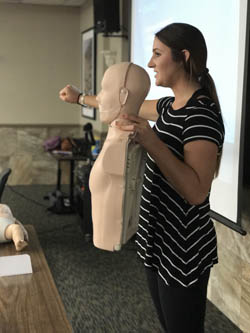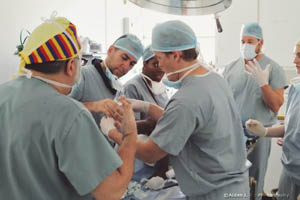How You Can Help When Fire Disaster Strikes
“Look for the helpers. You will always find people who are helping.”
 It’s the advice Mr. Rogers’s mother gave him when he was a child and saw scary news on television. Fred Rogers went on to teach a generation of children to do the same. There is a lot of scary news coming out of California in recent weeks. There are also a lot of helpers. Volunteering during or in the aftermath of a disaster can lessen the burden on traumatized victims and ease the strain on first responders. The inclination to help in the wake of any disaster is strong and part of our human nature. “It’s important to let people help,” according to Caroline Hackerott, a disaster researcher and Assistant Professor of Arkansas Tech University’s Emergency Management Department. Hackerott studies how disasters impact a community and the social disruption to people’s lives and their communities after a disaster. “People in the disaster affected community know what their community needs are.”
It’s the advice Mr. Rogers’s mother gave him when he was a child and saw scary news on television. Fred Rogers went on to teach a generation of children to do the same. There is a lot of scary news coming out of California in recent weeks. There are also a lot of helpers. Volunteering during or in the aftermath of a disaster can lessen the burden on traumatized victims and ease the strain on first responders. The inclination to help in the wake of any disaster is strong and part of our human nature. “It’s important to let people help,” according to Caroline Hackerott, a disaster researcher and Assistant Professor of Arkansas Tech University’s Emergency Management Department. Hackerott studies how disasters impact a community and the social disruption to people’s lives and their communities after a disaster. “People in the disaster affected community know what their community needs are.”
There are lots of ways to become a helper during and after a disaster, but before jumping into any disaster response volunteers must be ready and properly trained, explains Ready.gov. Every disaster is different so every response is different. Due to those differences in disasters and disaster plans, a volunteer must never just jump into action, doing so compromises their own safety, the safety of first responders, and those impacted by the disaster.
The first step to getting involved is finding the right organization that needs your help. There are plenty. Individuals with a background in healthcare may be more suited for certain types of disaster relief, but those with experience in, say, supply chain management or IT or electrical work are also important. Almost any skill set can be useful when applied at the right time. Chaplains and faith-based volunteers are as key as accountants willing to help people fill out forms and paperwork.
Michael Noone is a disaster response coordinator and literally wrote the book on this topic when he authored ‘How to Become an International Disaster Volunteer.’ “With the recent California wildfires, there’s still thousands of people displaced. Imagine yourself spending Thanksgiving, even Christmas, in a shelter. The Holidays with your family and pets in the shelter. There’s a need for doctors, nurses, paramedics and general volunteers at the shelter,” he says. Noone also points out that not all help is actually helpful. “Please do not donate used clothing or canned goods unless it’s specifically asked for. In general, it’s usually much more expensive to ship clothing, food and water to a disaster area than resourcing it locally. Also, many shelters cannot accept fresh baked goods because of local health regulations so call ahead before you bring down a pan of brownies.”
 Another devastating part of any disaster is the psychological toll is takes. The impact on victims is of course the most severe, but first responders and even volunteers are also at risk. “When someone volunteers after a disaster, they need to take into account their own mental health,” says Noone. “They may see some very disturbing things. It may not be blood and gore, but it will affect them psychologically.” Mary Massey, Hospital Preparedness Coordinator with the California Hospital Association served as Deputy Commander in the public health response to the California Camp fire, she knows first-hand the emotional toll a major wildfire continues to take on people after the flames are extinguished. “Responders are so used to taking care of others that we are trying to learn to take care of ourselves. We forget that we need care too. Small things, like having enough pillows or toilet paper filled in the portable toilets are tiny comforts that can go a long way for the responders emotionally.” Massey reports that officials have opened Local Assistance Centers (LAC) in California thanks to funding from federal, state and private partners. Resources and information, including behavioral health support, is getting to the public.
Another devastating part of any disaster is the psychological toll is takes. The impact on victims is of course the most severe, but first responders and even volunteers are also at risk. “When someone volunteers after a disaster, they need to take into account their own mental health,” says Noone. “They may see some very disturbing things. It may not be blood and gore, but it will affect them psychologically.” Mary Massey, Hospital Preparedness Coordinator with the California Hospital Association served as Deputy Commander in the public health response to the California Camp fire, she knows first-hand the emotional toll a major wildfire continues to take on people after the flames are extinguished. “Responders are so used to taking care of others that we are trying to learn to take care of ourselves. We forget that we need care too. Small things, like having enough pillows or toilet paper filled in the portable toilets are tiny comforts that can go a long way for the responders emotionally.” Massey reports that officials have opened Local Assistance Centers (LAC) in California thanks to funding from federal, state and private partners. Resources and information, including behavioral health support, is getting to the public.
Those interested in helping during or after a wildfire should consider getting involved with Fire Corps. Started in 2004, the group actively recruits volunteers who assist fire and EMS departments in non-emergency roles. This vital help frees fire personnel to focus on emergencies. Fire Corps is active in 49 states and its volunteers assist in tasks such as providing what is called rehab or canteen services for first responders which means getting them food and water while they are on duty, to pre planning and conducting research for emergency incidents.
The type of work open to volunteers is limited only by the needs of the department and are vast according to Fire Corps, it also stresses that it needs volunteers with a wide variety of skill sets.
Some other trusted groups out there actively recruiting volunteers for different kinds of disasters include The Medical Reserve Corps and the Citizens Corps. Those with a background in healthcare should consider the Medical Reserve Corps, a partner program under the Citizen Corps, it uses volunteers who have an occupational history in medical and public health professions. Citizen Corps, was created in response to the September 11, 2001 attacks and designed to capture the spirit of service and commitment that sprang up in the aftermath of that tragic day. Citizen Corps connects volunteers from both healthcare and non-healthcare fields.
 The work of these groups is particularly close to the heart of all of us at the Disque Foundation. Our Executive Director, Dr. Karl ‘Fritz’ Disque, was part of a large team of physicians that traveled to Haiti after the devastating earthquake in 2010. The misery was intense and the working conditions extremely challenging. Despite that, his team was able to save a lot of lives. Fritz came away from that experience inspired to continue giving back in places like Haiti because more training would mean more lives saved. The Disque Foundation now actively partners with groups all over the country and the world training health care professionals and the population at large to save a life through CPR certification.
The work of these groups is particularly close to the heart of all of us at the Disque Foundation. Our Executive Director, Dr. Karl ‘Fritz’ Disque, was part of a large team of physicians that traveled to Haiti after the devastating earthquake in 2010. The misery was intense and the working conditions extremely challenging. Despite that, his team was able to save a lot of lives. Fritz came away from that experience inspired to continue giving back in places like Haiti because more training would mean more lives saved. The Disque Foundation now actively partners with groups all over the country and the world training health care professionals and the population at large to save a life through CPR certification.
The Disque Foundation’s work in the Philippines is particularly illustrative of our mission. The foundation partnered with the Bravo Zulu First Aid and Safety Team (BZFAST) there to help train volunteers in basic life support. Things work a little differently in the Philippines and BZFAST volunteers are a part of first responder teams for all kinds of emergencies, including fires. The Disque Foundation team brought CPR and first aid training to the group which then went on to train many more BZFAST participants. That’s Disque’s mission and our inspiration – exponentially growing the number of people empowered to save a life in an emergency.
As of this writing, the Camp Fire in Northern California has killed at least 85 people and destroyed nearly 18,000 structures. The Woolsey fire in Southern California has killed three people and burned almost 100,000 acres, and destroyed 1,500 structures. The news cameras will leave, and media attention will fade but we know the trauma will continue for a long, long time. Communities and individuals will continue to need qualified helpers for a long time.
Volunteers have an opportunity to make a difference in the lives of those affected by disasters by making themselves deployable through preparation and training. Sign up for an online CPR, AED and First Aid certification course today. Knowing what to do in a disaster can, does and will help you save lives.
